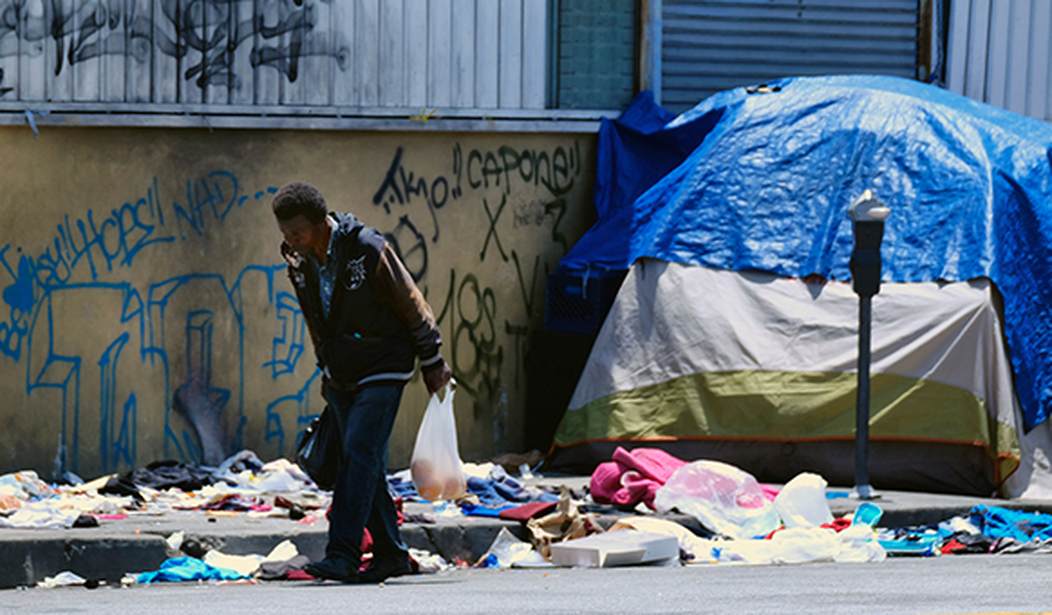POLITICO wrote a very long, and “important” piece about California’s Project Roomkey (now Homekey), and how it could change the face of California’s homelessness crisis, and maybe resolve it nationwide.
With 50 percent of the nation’s homelessness isolated to California, it appears it is a crisis of our own making; especially since homelessness has been on decline in every other state except California and New York.
USAFacts.org, a non-partisan organization that tracks this, has California homelessness at 161,548. New York is the second highest with 91,271. Every other state goes down from there and doesn’t even reach to 30,000. The statistics shows data from 2007-2020, and California, New York, and Massachusetts (17,975) are the only states where homeless has increased. The other 47 states have decreased their rates of homelessness.
So this so-called solution to California’s unique problem should also be isolated to the state and should not reach beyond its borders. Other states appear to be doing just fine managing their homeless. The same cannot be said for California.
In too many words, POLITICO is doing what it does best: Polishing Governor Gavin Newsom’s turds.
The first lie the publication perpetrates is that almost 30 percent of chronically homeless are not the root of the homelessness problem. The writers present a picture that the other 70 percent or so of homeless individuals are people experiencing hard times.
When people think of homelessness, they often picture the visibly and chronically homeless — many of whom suffer from mental illness, behavioral disorders and substance abuse issues that keep them from holding down jobs. But chronic cases actually comprise a minority of the population. In California, only 30 percent of the people experiencing homelessness in January 2020 had been homeless for at least 12 months of the previous three years, according to a HUD count, which means about 70 percent were newly homeless — often low-income people who’d fallen on hard times and found themselves without a home for the first time in their lives.
“What you don’t see are that many, many of those folks who are out there are getting out of their tents and going to jobs,” said Margot Kushel, head of the Benioff Homelessness and Housing Initiative in San Francisco. Kushel, a physician who has studied homelessness’ impact on health, was one of the experts in the room when Newsom’s staff came up with the hotel conversion plan.
This is published fiction, as can be seen by anyone who lives in a major city center like San Francisco or Los Angeles. Journalist Erica J. Sandberg follows homelessness closely, and writes about the crises that exist in San Francisco because of it. She has written about community programs (like Urban Alchemy and the Positive Directions Treatment, Recovery, and Prevention Program) that work to alleviate homelessness and rebuild human lives; so she also recognizes when something does not work.
I asked her if she had read the POLITICO piece, and she indeed had.
“That article was insane. It’s like it was written by someone who is an alien, that’s how insane it was,” she said.
When asked about her assessment of the Project Roomkey model, she had much to say—none of it positive.
“They have rebranded them to ‘Permanent Support Housing.’ Here’s the problem: Take out the word “support.” There is no “supportive” in this equation,” she said.
“You are taking people with very serious problems and placing them in housing without any structure or support. It’s a recipe for disaster.”
POLITICO features glossy pictures of two individuals who have been placed in the new “Homekey” program, and who fit the “citizen down on their luck,” profile, as well as gorgeous views of the new facilities.
The article interviews “leaders” on the homelessness front in California. Frankly, the same leaders who have been overseeing the ballooning crisis while lining their own pockets.
The nonprofit PATH (People Assisting the Homeless), is one such organization. Three women were just indicted by Secy of State Rob Bonta on fraud and corruption charges involving the organization. How many more of these organizations are also not operating above board and no one is calling them out?
These leaders quickly blame everything from the housing shortage, to the NIMBY (not in my backyard) mentality of the Uber wealthy as the reasons the homeless cannot be housed.
California has been throwing ever-larger sums of money at homelessness for years, only to see the homeless population continue to surge, increasing by 40 percent in just the last five years. What made Homekey different was the way it streamlined regulations in a state notorious for erecting some of the most onerous and costly barriers to the development of affordable housing.
The Homekey project — and others like it — gets around those hurdles by focusing on existing buildings handpicked by the communities themselves.
Assemblyman Kevin Kiley, one of Newsom’s fiercest critics, has never been shy about pointing out the failures of simply adding to the original $12 billion price tag to combat homelessness, rather than dealing with the root problems: mental illness and drug abuse.
“Everything he’s done in regard to the homeless has been a total failure. Newsom’s operating model seems to be to throw money at it, he said.
“There has been no evidence that this Project Roomkey model works. The state’s general operating budget has increased year after year, and the results have been less and less. Instead of reducing the amount of homelessness, we have seen it increasing.”
A week before the September Recall Newsom election, I wrote about the money already wasted on the pilot Project Roomkey, while hardworking citizens unhampered by substance or mental problems, still cannot not find housing in California. Yet, Newsom had no issue bending CEQA regulations for Project Roomkey, but not to build more affordable single-family dwellings.
California Globe also reported the truth about the waste in the pilot program:
Project Roomkey had become notorious for leaving hotel rooms largely vacant. At its highest point, the state only filled out about half of the hotel rooms it had rented, with statistics from May showing that only around 7,000 of the 17,000 hotel rooms had been filled. While counties such as Sacramento and San Francisco were well above the filled-room average, counties such as San Diego and Orange barely reached a quarter filled. In the city of Los Angeles, the filled percentage never reached above 30%.
[…]
“It was a $100 million program that, in the end, only housed less than 5,000 people,” former county-homeless liaison Edgar Powe explained to the Globe. “Not only was it mismanaged, but they forgot how many homeless people actually volunteer for this sort of thing.”
“Seasoned homeless people are vary wary of relocations because they have been burned by them before, such as anytime they are forced out of areas for big events that come up. Others prefer the street and there is no helping them. Others have a line on more stable housing and don’t want to jeopardize it. Others didn’t want that 7 P.M. curfew and found it insulting. And the list goes on.”
POLITICO didn’t bother to visit San Francisco, where the Project Roomkey facilities open only a few months, are already being overrun by the chronically homeless OUTSIDE of the facility, as well as inside.
#SF is to purchase Panoramic, the 3 year old apartment building to convert to a homeless hotel. Not only are there already drug dealers covering this intersection, but blocks away @LondonBreed is putting in a meth sobering center.
Will this make things worse or better? pic.twitter.com/ztZnt3GXGe
— CleanUpSOMAWest (@CleanUpWestSoma) September 10, 2021
Sandberg spoke truth to power:
“They have created complete chaos, inside the hotels and in the community.
“What happened on the outside is occurring inside. People treat it like it’s the outside. Sh*tting inside of rooms. It’s not okay. It’s not a solution, nor is it ethical.”
Asm. Kiley was equally pointed:
“The government approach gets it backwards.
“It’s hard to get someone invested in taking the steps to rebuild their lives when you give them a room without the resources. There should be some form of transitional housing that offers treatment or mental health counseling.
“Have facilities away from where people live. Away from the residential center of a town.”
Essentially, this is not about ending homelessness, because that would involve actually treating the homeless as human beings and offering them the help they need to be sober, sentient, and garner tools to become a part of the community and navigate society. The solutions that Dr. Drew Pinsky posits are in the right direction, but the so-called leaders in the homelessness industry decided he was unfit to be part of a Los Angeles Commission on homelessness. As long as these people get to collect a paycheck, they’ll keep homelessness going until the end of time.
Sandberg points out the true motivations behind propping up an obviously flawed program as the solution to homelessness:
“It alleviates the guilt when they [the elites] see people out on the streets. If they no longer see them on the street—poof! Problem solved. It allows politicians to say, see, I’m doing something!
“It’s a big, colossal waste of money, and a big, colossal waste of human empathy.
“It makes so angry,” Sandberg said.
Project Roomkey creates the illusion that as long as the homeless are stuffed into some form of housing, rather than also addressing the issues that made people homeless in the first place, then the problem is resolved. What is not an illusion is the abject lack of compassion behind this social engineering scheme. Just as the state is doing with this insane push to vaccinate people, it is doing with this push to get homeless off the streets: one-size fits all, and one solution will solve everything. If you cannot get on board with the solutions imposed by the state, then you are simply someone who doesn’t want the problem to be solved.
“We’re not objects you just set someplace. There is no such thing as ‘putting people’ – it’s really offensive to say you’re moving people around, like animals in a cage,” Sandberg said.
“No one who reports on this has been inside the hotels. But, if you want to focus on the anomalies, go for it.”














Join the conversation as a VIP Member